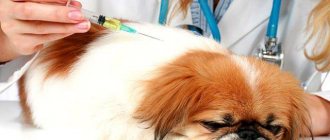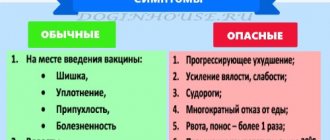Vaccinations are the first veterinary procedure a healthy puppy encounters.
Vaccination helps develop immunity against dangerous and often fatal diseases. It reduces the risk of infection by 90%, and if the dog does catch the virus, he has a high chance of being cured.
An unvaccinated dog cannot be transported across the country or abroad; it will not be allowed to participate in exhibitions and competitions. As soon as the kitten appears in the house, you need to think about vaccination, find out when and against what diseases the puppy is first vaccinated, how to prepare the baby for manipulation and what to do after.
What is vaccination
It is important for every owner to know that a powerful immune system protects your pet from illness. In the first weeks of life, the puppy’s body is protected by maternal antibodies, which it receives from milk. As you grow and switch to new diets, your immune system weakens. During this period, planned vaccination activities allow maintaining immunity.
A vaccine is an artificially created preparation containing weakened or non-viable forms of certain pathogens of infectious diseases. Its introduction causes a response, manifested by the creation of antibodies - immune protection against microorganisms that persists for a certain time.
Vaccination of a pet is a mandatory event. Lack of contact with street animals and constant presence in a limited area of the apartment does not guarantee that your pet will not get sick. After all, you yourself can become a source of infection - pathogenic microorganisms penetrate the room:
- when ventilating;
- with water and food;
- on your clothes, shoes;
- on all things entering the house from the outside.
The vaccine is not a medicine, but its use helps prevent possible infectious diseases. If the disease has already begun, vaccination will be useless.
Compared to the required course of treatment:
- vaccination is much cheaper;
- its implementation is much easier to tolerate even for a small kitten;
- effectiveness exceeds any methods of limiting contact or preventing infection of the animal.
As a preventative measure, vaccination is the most reliable and easily implemented way to keep your dog healthy.
What vaccinations are given to puppies up to one year old?
Vaccination of puppies usually begins at the age of eight to nine weeks. Vaccination at an earlier age is possible, but not required.
You can vaccinate from 6 weeks of age if there is an increased risk of infection, an unvaccinated puppy is to be transported, the puppy was born from unvaccinated parents, and there is a suspicion that the newborn lacks immunity.
If you have adopted an adult dog that has not been vaccinated before, then the dog will receive a comprehensive vaccine. It is given once every year, and animals usually tolerate this vaccine well.
According to the standard schedule, puppies are vaccinated against canine distemper, parvovirus enteritis, hepatitis, leptospirosis, parainfluenza, rabies, and adenovirus. When the vaccination period is missed, or there is no information about whether the animal is vaccinated, the doctor will propose an individual vaccination regimen.
Attention! Do not try to vaccinate your pet yourself at home. This can only be done by a veterinarian in the clinic, taking into account the condition, physiological characteristics and age of the animal.
Vaccination schedule for dogs using clinic medications
There are two vaccination schedules. The first is according to the manufacturer’s instructions, the second is according to the recommendation of WSAVA (International Small Animal Veterinary Association). Depending on the condition of the pet and the conditions under which it is kept, the doctor will suggest the most suitable option. The final decision is up to the owner.
WSAVA recommends a series of additional booster vaccinations at a young age. In the first weeks of life, puppies and kittens are protected by maternal antibodies. As long as antibody levels remain high, vaccination may not work. And it decreases differently for everyone. Some may respond to vaccination at 2 months, others remain protected for up to 4 months. As a result of this discovery, WSAVA began recommending additional vaccinations.
The manufacturer's instructions give a standard schedule: the first vaccine at 8–9 weeks, revaccination after 3–4 weeks and then once a year. If you start vaccination at an older age, the scheme will be the same. When drugs enter the territory of the state, they undergo certification, and instructions for use are prepared. This is a rather lengthy and complex process. However, science does not stand still; new features of the effectiveness of drugs are being discovered. This happened with the timing of recommended vaccinations. At the time of the formation of the instructions, it was believed that it was enough for a puppy or kitten to undergo a single revaccination with an interval of 3–4 weeks and then revaccination once a year. However, vaccine manufacturers have begun to frequently receive information about cases of viral infections in animals vaccinated at an early age. As a consequence of this finding, WSAVA began to recommend a series of additional booster vaccinations at a young age.
Research takes a lot of time, and passing a new law requires even more time. This is why you can sometimes see such discrepancies in the instructions for use of the vaccine and the WSAVA guidelines.
Nobivak vaccination scheme (Netherlands):
Composition of the drug:
- D - plague of carnivores.
- H - hepatitis.
- P - parvovirus enteritis.
- Pi - parainfluenza.
- Lepto - leptospirosis.
- R - rabies.
4-6 weeks - Nobivak Puppy DP, KC (canine distemper, parvovirus enteritis, parainfluenza, bordetellosis). This vaccine is not used often, mainly by breeders, so it can be purchased on order. Most often, the drug is used before selling, transporting a puppy, in cases of illness in the owner’s other pets, as well as when purchasing a puppy under 8 weeks old.
8 - 9 weeks - Nobivak DHP, DHPPi + Lepto (R) (canine distemper, hepatitis, parvovirus enteritis, leptospirosis, rabies).
12 weeks - Nobivak DHP, DHPPi + Lepto (R) (immune strengthening).
Revaccination:
First and second years - Nobivak DHP, DHPPi + Lepto.
Third year - Nobivak DHP, DHPPi + Lepto (R).
Next we follow the revaccination scheme.
Vaccination scheme Eurikan (France):
8-9 weeks - Eurikan DHPPi2 + Lepto (canine distemper, parvovirus enteritis, hepatitis (adenovirus) type 2, parainfluenza type 2 (bordetellosis / kennel cough), leptospirosis).
12 weeks - Eurikan DHPPi2 + Lepto (R).
Revaccination:
12 months - Eurikan DHPPi2 + Lepto (R).
Then annually from the last date of vaccination.
Types of vaccines
There are two types of drugs - inactivated and attenuated, so-called “live” vaccines. Each of them has its own advantages and features.
Attenuated vaccines contain live, weakened microorganisms. They are not capable of causing disease, but provoke an immune response. Thus, the body already has experience in fighting the pathogen, and if it encounters it, it knows what to do.
When an inactivated (killed) vaccine is administered, the immune system will not be as intense, but this is the best choice for particularly dangerous diseases, such as rabies.
As a rule, the first vaccination against major diseases is carried out twice, with an interval of 2–4 weeks. Then it is repeated every year to maintain a full immune response in case of infection.
The composition of vaccines can be single-component (monovalent) or complex (polyvalent). Single-component drugs build immunity to a specific infection, for example, canine distemper. Single-component vaccines are not popular due to the widespread use of multi-component vaccines, but in case of risk of epizootics they are sometimes used. Complex (multicomponent) vaccines have their advantages. They form immunity to several infections at once, which allows you to relieve your dog of stress when visiting the clinic and get by with just one injection.
Preparing and deworming your dog before vaccination
- Before each vaccination, the dog must undergo a veterinary examination by a doctor. The animal must be completely healthy.
- Seven to ten days before vaccination, deworm your dog (get rid of worms). An untreated pet can be vaccinated, but it is not advisable. Without treatment, vaccine side effects are more likely to occur. Your veterinarian will tell you how to worm your dog before vaccination and what medications to use for deworming. But you can carry out the procedure yourself by reading the article or consulting a doctor at the clinic.
- Small puppies should not be walked before the first vaccination, and if you are impatient to do this, then carry the puppy in your arms for a short time.
Possible complications: distinguishing normal from pathological
Animals' bodies weaken after any vaccination, and they feel lethargic for several days. The very first vaccination is especially difficult for dogs. Maybe:
- short-term increase in temperature to 39°C;
- painful swelling at the injection site;
- one-time refusal to eat;
- single vomiting and diarrhea;
- lethargy and malaise - the puppy will sleep a lot, get tired quickly, and refuse to play.
These are normal side effects. There is no need to be afraid of them.
You need to contact a veterinary hospital if your baby has:
- high temperature (40°C) that does not subside for a couple of days;
- lack of appetite - he does not eat for more than a day;
- prolonged diarrhea and vomiting – more than 1 day;
- copious discharge from the nose, eyes, drooling;
- convulsions.
This behavior is abnormal and requires urgent medical attention.
Like any drug, serum can cause allergies. It will cause shortness of breath, itching at the injection site, cyanosis of the mucous membranes, rash, redness, and drowsiness.
It is recommended to vaccinate at home or not leave the clinic for 15 to 30 minutes. Half an hour is the time during which an allergic reaction to the drug manifests itself.
If negative symptoms occur, the doctor will take the necessary measures.
Quarantine
After each vaccination, your pet must undergo a two-week quarantine. The fact is that a dog’s strong immunity is formed during this time, and the vaccine will not yet be able to protect its body from infection. During this period, it is not recommended to walk the dog, bathe it, overcool it, or subject it to physical activity. If there are other animals in the house that go outside, it is better to prevent the dog from coming into contact with them.
General rules
There are a number of rules that must be followed so that vaccination is as gentle as possible and does not harm the baby.
- The puppy must be absolutely healthy . A vaccine is essentially a compound that provokes the disease for which it is intended, but in a mild form. Having been ill once, the dog develops its own immunity. If the puppy is not healthy, then vaccination will be too difficult for the baby.
- Two weeks before vaccination you need to carry out anti-worm therapy . Worms weaken the body, and in combination with the administered drug, this can lead to tragic consequences.
- The first 12 days after vaccination are difficult for the puppy ; diarrhea, depression, high fever, and lethargy may be noted. It is advisable that one of the family members be with the dog.
Documentation of vaccination
If your pet will participate in exhibitions, or you will simply take it abroad, you will need an international veterinary dog passport. It lists all the vaccinations your dog has received.
Also, when traveling abroad, you may need to prepare additional documents for transportation (issued in state veterinary clinics). In EU countries, a dog, among other things, will need to have an implanted electronic chip, that is, the dog will need to be microchipped.
Our clinic is certified according to international standards and provides, among other things, microchipping services. This simple procedure is painless and harmless for the animal. The chip is the size of a grain of rice and is implanted under the skin in the withers area. It allows you to read information about your pet and the owner. The information is read after entering a unique code (15 characters) into the database.











